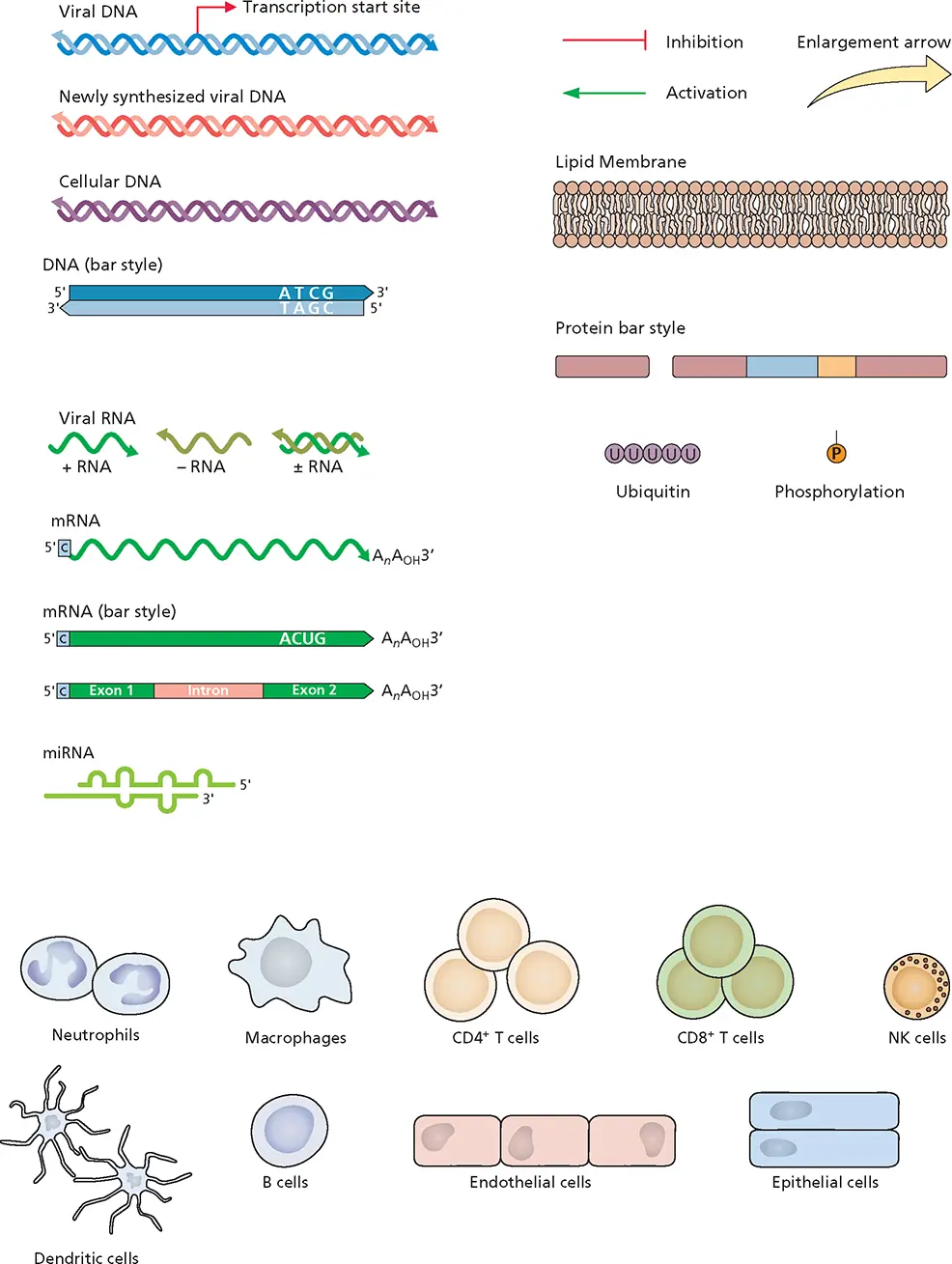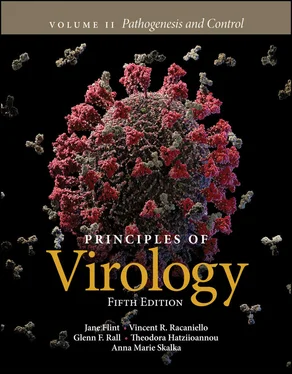S. Jane Flint - Principles of Virology, Volume 2
Здесь есть возможность читать онлайн «S. Jane Flint - Principles of Virology, Volume 2» — ознакомительный отрывок электронной книги совершенно бесплатно, а после прочтения отрывка купить полную версию. В некоторых случаях можно слушать аудио, скачать через торрент в формате fb2 и присутствует краткое содержание. Жанр: unrecognised, на английском языке. Описание произведения, (предисловие) а так же отзывы посетителей доступны на портале библиотеки ЛибКат.
- Название:Principles of Virology, Volume 2
- Автор:
- Жанр:
- Год:неизвестен
- ISBN:нет данных
- Рейтинг книги:3 / 5. Голосов: 1
-
Избранное:Добавить в избранное
- Отзывы:
-
Ваша оценка:
- 60
- 1
- 2
- 3
- 4
- 5
Principles of Virology, Volume 2: краткое содержание, описание и аннотация
Предлагаем к чтению аннотацию, описание, краткое содержание или предисловие (зависит от того, что написал сам автор книги «Principles of Virology, Volume 2»). Если вы не нашли необходимую информацию о книге — напишите в комментариях, мы постараемся отыскать её.
Volume I: Molecular Biology
Volume II: Pathogenesis and Control
Principles of Virology, Fifth Edition
Principles of Virology, Volume 2 — читать онлайн ознакомительный отрывок
Ниже представлен текст книги, разбитый по страницам. Система сохранения места последней прочитанной страницы, позволяет с удобством читать онлайн бесплатно книгу «Principles of Virology, Volume 2», без необходимости каждый раз заново искать на чём Вы остановились. Поставьте закладку, и сможете в любой момент перейти на страницу, на которой закончили чтение.
Интервал:
Закладка:
Theodora Hatziioannouis a Research Associate Professor at Rockefeller University in New York. Throughout her career, Dr. Hatziioannou has worked on multiple viruses, with a particular focus on retroviruses and the molecular mechanisms that govern virus tropism and on the improvement of animal models for human disease. She is actively involved in teaching programs at the Rockefeller University and the Albert Einstein College of Medicine, is an editor of Journal of General Virology , and serves as a reviewer for multiple scientific journals and NIH grant review panels.
Anna Marie Skalkais a Professor Emerita and former Senior Vice President for Basic Research at the Fox Chase Cancer Center in Philadelphia. Dr. Skalka’s major research interests are the molecular aspects of retrovirus biology. Dr. Skalka is internationally recognized for her contributions to the understanding of the biochemical mechanisms by which such viruses (including the AIDS virus) replicate and insert their genetic material into the host genome. Both an administrator and researcher, Dr. Skalka has been deeply involved in state, national, and international advisory groups concerned with the broader, societal implications of scientific research. She has also served on the editorial boards of peer-reviewed scientific journals and has been a member of scientific advisory boards including the National Cancer Institute Board of Scientific Counselors, the General Motors Cancer Research Foundation Awards Assembly, the Board of Governors of the American Academy of Microbiology, and the National Advisory Committee for the Pew Biomedical Scholars.
Key of Repetitive Elements

1 Infections of Populations: History and Epidemiology

Introduction to Viral Pathogenesis
A Brief History of Viral PathogenesisThe Relationships among Microbes and the Diseases They Cause The First Human Viruses Identified and the Role of Serendipity New Methods Facilitate the Study of Viruses as Causes of Disease
Viral Epidemics in History Epidemics Shaped History: the 1793 Yellow Fever Epidemic in Philadelphia Tracking Epidemics by Sequencing: West Nile Virus Spread to the Western Hemisphere Zoonotic Infections and Epidemics Caused by “New” Viruses The Economic Toll of Viral Epidemics in Livestock Population Density and World Travel Are Accelerators of Viral Transmission Focus on Frontline Health Care: Ebolavirus in Africa Emergence of a Birth Defect Associated with Infection: Zika Virus in Brazil
Epidemiology Fundamental Concepts Methods Used by Epidemiologists Surveillance Network Theory and Practical Applications
Parameters That Govern the Ability of a Virus to Infect a Population Geography and Population Density Climate
Perspectives
References
Study Questions
LINKS FOR CHAPTER 1
Video: Interview with Dr. W. Thomas London http://bit.ly/Virology_London
Epidemiology causes conclusions (p less than 0.01) http://bit.ly/Virology_Twiv169
Slow motion sneezing http://bit.ly/Virology_1-23-13
CD4 Hunter http://bit.ly/Virology_Twiv489
Swords, lances, arrows, machine guns, and even high explosives have had far less power over the fates of nations than the typhus louse, the plague flea, and the yellow-fever mosquito.
HANS ZINSSER
Rats, Lice and History , 1934
Introduction to Viral Pathogenesis
While the title of Zinsser’s classic volume Rats, Lice and History may trigger a wry smile (for how, after all, could lice be part of history?), the ideas proposed in this famous history of pathogens and the diseases they cause remain as relevant today as when they were published in 1934. As Zinsser argued, the global impact of pathogens, including viruses, has shaped human history as much as any war, natural disaster, or invention. This view may seem an exaggeration to today’s student of virology, who may perceive most viral infections as annoyances that result in a few missed classes or days of work. But in the context of history, epidemicsof smallpox, yellow fever, human immunodeficiency virus, and influenza have caused an incalculable loss of life and have changed entire societies. Smallpox alone killed well over 300 million people in the 20th century, more than twice the number of deaths from all the wars that occurred in the same time period. Huge empires fell to a relatively small number of invaders, in part because the conquerors inadvertently introduced viruses that crippled the empires’ defense forces. Not all such victories were accidental, however: in the 1760s, British traders offered blankets and handkerchiefs from the smallpox hospital at Fort Pitt to American Indians who had never been exposed to this pathogen. As William Trent, one of the traders, noted, “I hope it will have the desired effect.” Smallpox, used in this way, was the first bioweapon.
Although vaccines and antivirals have reduced, and even eliminated, some of these scourges, we are reminded of the challenges we still face by the looming threat of an influenza pandemic, the devastation caused by Ebolaviruses in Africa, the lack of success in developing a human immunodeficiency virus vaccine, and the resurgence of vaccine-preventable infections. We also face the emergence of “new” human viral pathogens, such as the coronavirus that is the cause of the worldwide pandemic in 2019–2020, and Zika virus, which causes gross defects in brain formation. Of equal importance, viruses that cause disease in crops and animals have crippling consequences for the infected species, the farmers who depend on them for their livelihoods, and human populations that may face starvation.
The ways that viruses cause diseases in their hosts, the tug-of-war among viruses and the host’s defenses, and the impact that viral epidemics have had on human, animal, and plant populations are therefore not just interesting academic pursuits, but rather life-and-death issues for all organisms. That said, it is important to bear in mind this critical principle: pathogenesis(the processes that lead to disease) is often a collateral outcome of the parasitic nature of viruses. As is true for humans, selective pressures that control evolution of viruses act only on their abilities to survive and reproduce. From this perspective, one could argue that the most successful viruses are those that cause no apparent disease in their natural host.
In the first chapter of Volume I, we recounted an abbreviated history of virology and described milestones that established the foundation for our current understanding of viral reproduction. In this chapter, we return to history, focusing on watershed events that catalyzed the fields of viral epidemiologyand pathogenesis. Subsequent chapters in this volume will consider the impact of viral infections on individual hosts, tissues, and cells. Our goal in Volume II is to build on the principles of viral reproduction that were established in Volume I, providing an integrated view of how viruses cause disease in single cells, discrete hosts, and large populations, as well as the host responses that mitigate or prevent such diseases.
PRINCIPLES Introduction to viral pathogenesis
Diseases associated with viral infections are a collateral outcome of the parasitic nature of these pathogens.
Читать дальшеИнтервал:
Закладка:
Похожие книги на «Principles of Virology, Volume 2»
Представляем Вашему вниманию похожие книги на «Principles of Virology, Volume 2» списком для выбора. Мы отобрали схожую по названию и смыслу литературу в надежде предоставить читателям больше вариантов отыскать новые, интересные, ещё непрочитанные произведения.
Обсуждение, отзывы о книге «Principles of Virology, Volume 2» и просто собственные мнения читателей. Оставьте ваши комментарии, напишите, что Вы думаете о произведении, его смысле или главных героях. Укажите что конкретно понравилось, а что нет, и почему Вы так считаете.



